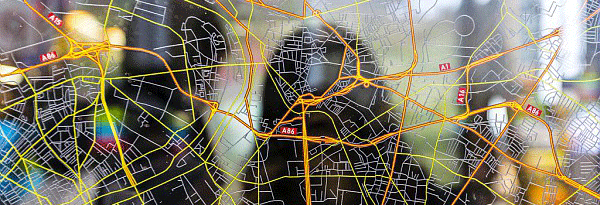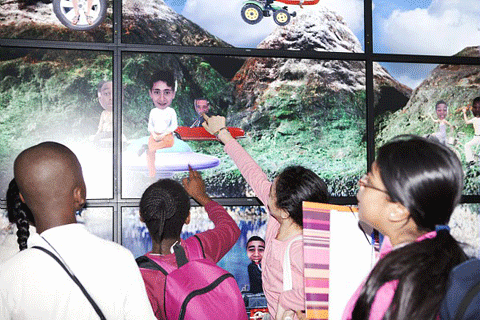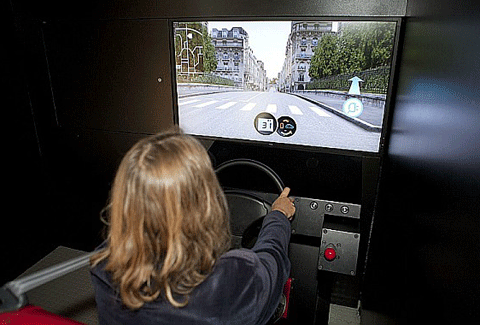Mobile, but at what price? Super-nomads, we now travel more frequently, further and faster than ever before. Demographic explosion, urbanisation, development of emerging countries, widespread use of transport... All these factors are involved in the explosion of "free" mobility, encouraged by tourism and leisure.
This hyper-growth has to stop to make way for sustainable mobility, which is respectful of the environment, takes economic considerations into account and is in step with the needs of tomorrow. Between changes to public transport, the well-being of users and "eco-responsibility", we need to rethink our transport systems and their relationship to land use, urbanisation, economic lifestyles and society.
The exhibition is divided into 3 areas based on diverse layouts and audiovisual displays, installations, interactive multimedia tables, models and driving simulators, asking questions and preparing us to face the challenge of our mobility.
1. Why do we travel?
The first area in the exhibition explores the reasons why we travel and the creativity of modes of transport and usage that they give rise to.
There are many reasons why people travel or remain in one place. In a space with unequally distributed resources, travel is a necessary part of human activity. The meaning and the value attached to travel vary according to time and place: while commuting is often seen as a constraint, tourism is considered as a self-fulfilment at it's best, whereas migrants are prevented from travelling.
In the exhibition, don’t miss:
- The game: an interactive and collective piece. This work by the artist Pierrick Sorin symbolises the idea of movement and travel. The visitors are the participants: after having their photo taken, their digitised faces appear in the game, associated with representations of mobile objects that travel across a landscape.
- The mixer is an interactive multimedia display on the theme of "transmodality", in other words the mixing of several forms and modes of transport, both collective and individual, public and private. These hybrids offer great variety, for example: A scooter + a boat = a sand yacht.
2. How do we travel?
The second area of the exhibition addresses current changes in terms of modes, usage and environments, based on two major themes: "Travel and land use" and "Transport issues".
"Travel and land use" focuses on personal travel, which has increased continuously since the middle of the 20th century, particularly with the growth of the automobile and air transport, a major factor in global travel. This theme also raises the great variety of human activities where millions of people meet in stations, airports and on the roads, during short or long journeys. Finally, it considers the development of complex transport networks in major cities and accessibility of different places, often linked to the social status of individuals.
"Transport issues" looks at collective modes of transport, which have grown continuously since the 1970s without ever actually properly meeting peoples' needs. Today cars are still often the only efficient way to travel. Collective and individual modes of transport should be reorganised to become complementary, compatible and coordinated. The development of information technology will contribute to this change.
In the exhibition, don’t miss:
- Aerial ballet: hypnotic visualisation of air traffic over 24 hours. This world map covered in a myriad of bright points shows air traffic over 24 hours in one minute. Each day, almost 20,000 airliners, represented by this number of coloured dots, make around 80,000 flights, connecting 14,000 airports. One airplane takes off while another one lands every second. You can see the major planetary flows and the influence of night time on air traffic.
- Grand scale: these superimposed maps demonstrate the complexity of air, rail and road networks in Ile-de-France.
- Eco-driving simulators: Visitors can have a go on two driving simulators, a PSA micro-hybrid vehicle ("start and stop") and a Renault electric vehicle, to learn to adapt their driving behaviour to save energy and improve safety.
Walkway with the permanent "Energy" exhibition, the space "2050, let's design the future" is presented as an individual and collective interactive multimedia display.
Visitors can play a game intended to reveal the efforts that the group is prepared to make to limit the effects of climate change due to human activity.
Players respond individually to a series of questions, which are summarised to produce a collective result: a future scenario. It ends with an audiovisual representation of the world, simulating the results of a collective vote, showing what the Earth would look like if it was subject to warming of 2°, 3° or 4° C.




